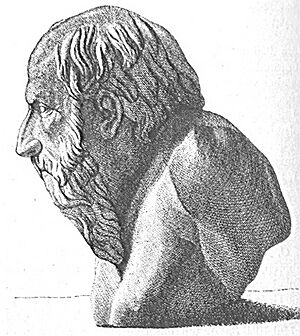Diogenes of Sinope facts for kids
Diogenes of Sinope (also known as Diogenes the Cynic) was an ancient Greek philosopher. He was born in the town of Sinope (now called Sinop, Turkey) around 412 BC. He passed away in the city of Corinth, Greece, in 323 BC.
After getting into trouble with money in his hometown, he was sent away. He then moved to Athens. Diogenes chose to live a very simple life. He didn't care about money, fame, or possessions. This way of living helped him criticize the problems he saw in society.
Diogenes believed that living without much was a good thing. He often begged for food and slept in a large ceramic jar in the marketplace. He became famous for his unusual actions. For example, he would carry a lamp during the day. He said he was looking for an honest person.
He often disagreed with other philosophers, like Plato. Diogenes even tried to disrupt Plato's lessons. He would bring food and eat during their discussions. Diogenes was also known for making fun of Alexander the Great in public.
Diogenes helped Antisthenes start cynicism. This is a way of thinking that focuses on living a simple life. It means not needing money, fame, power, or many things.
Diogenes was once captured by pirates and sold into slavery. He eventually settled in Corinth. There, he shared his ideas about cynicism with Crates. Crates then taught these ideas to Zeno of Citium. Zeno later developed stoicism, which became another important Greek philosophy.
None of Diogenes' own writings have survived. However, we know about his life from many stories. These stories come from a book called Lives and Opinions of Eminent Philosophers by Diogenes Laërtius and other old sources.
Contents
Diogenes' Simple Life
Diogenes believed that people should live naturally. He thought that society's rules often made life too complicated. He chose to live without a home or many belongings. He wanted to show that happiness doesn't come from owning things. It comes from being free and independent.
His Famous Actions
Diogenes was known for his unique ways of teaching.
- Living in a Jar: He famously lived in a large clay jar. This showed his rejection of traditional homes.
- Searching for an Honest Man: Carrying a lamp in daylight was a way to show how rare he thought honesty was.
- Challenging Others: He wasn't afraid to speak his mind. He often challenged powerful people and their ideas.
Diogenes and Other Philosophers
Diogenes lived at a time when many great thinkers were around. He had strong opinions about their ideas.
His Views on Plato
Diogenes often disagreed with Plato, another famous Greek philosopher. Plato believed in ideal forms and complex ideas. Diogenes, however, focused on practical, simple living. He sometimes made fun of Plato's teachings to show his point.
Meeting Alexander the Great
One of the most famous stories about Diogenes is his meeting with Alexander the Great. Alexander, a powerful king, visited Diogenes. He asked Diogenes if there was anything he could do for him. Diogenes famously replied, "Yes, stand out of my sunlight." This showed Diogenes' independence and his lack of interest in power or wealth.
The Legacy of Diogenes
Diogenes' ideas were very important. He helped start the Cynic school of thought. His way of life influenced many philosophers who came after him.
Cynicism Explained
Cynicism teaches that the purpose of life is to live in agreement with nature. It means rejecting desires for wealth, power, and fame. Cynics believe that true happiness comes from living simply and being self-sufficient.
Influence on Stoicism
Diogenes' ideas also influenced stoicism. Stoicism is another philosophy that teaches self-control and strength. It encourages people to accept what they cannot control and focus on what they can.
Images for kids
-
Diogenes Searching for an Honest Man (1640–1647) by Giovanni Benedetto Castiglione held at the National Gallery of Art
-
Diogenes Sitting in His Tub by Jean-Léon Gérôme (1860)
-
Plato and Diogenes (17th century) by Mattia Preti
-
Diogenes, c. 1527, Ugo da Carpi, Parmigianino in the collection of the National Gallery of Art, Washington, DC.
See also
 In Spanish: Diógenes de Sinope para niños
In Spanish: Diógenes de Sinope para niños











